During a period when “business as usual” was anything but, Dome Technology was fortunate to remain active, completing bulk-storage projects in the United States and abroad. In July 2021, the team completed a 30,000-metric-ton wood-pellet dome for Peeples Industries in Savannah, Georgia, USA, the third dome on site for the maritime industry leader.
Dome Technology performed the engineering and construction on all three domes, and the latest is like the first two; pellets are reclaimed via gravity to in-ground reclaim tunnels with a large door for easy front-loader maneuvering. According to company president Frank Peeples Jr., the company has been scaling tonnage “at a blinding pace” since the most recent commissioning and expects the tempo to continue.
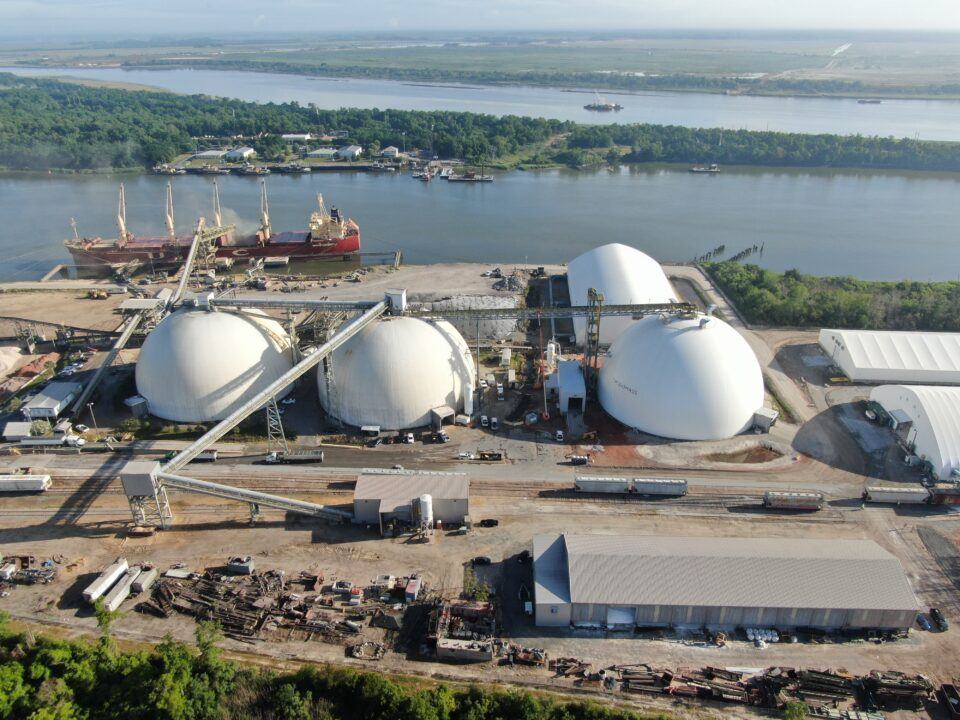
“We sincerely appreciate Dome Technology as the design engineer and general contractor for the recent completion of our Dome 3 construction for the storage and handling of export wood pellets through our facility in Savannah,” he wrote in a letter to Dome Technology after the project wrapped. “We did it again — another world-class, bar-setting dome facility that will serve our customer for years to come. It is hard to believe that we initiated this project in March (2020) during the early stages of the pandemic.”
The partnership between the two companies began in 2011 when Peeples selected one, then two domes after seriously considering a 50,000-ton A-frame for storing wood pellets. But an A-frame would have required deep foundations that raised financial concern — and there were rumblings that a better option might be on the market.
So company leadership contacted Dome Technology, “and they did a lot of things for us. They cheapened our price up because we didn’t have to put in a deep-pile foundation” — a system that for the A-frame would have carried the same cost as one entire dome, Peeples Industries project manager Brad Orwig said.
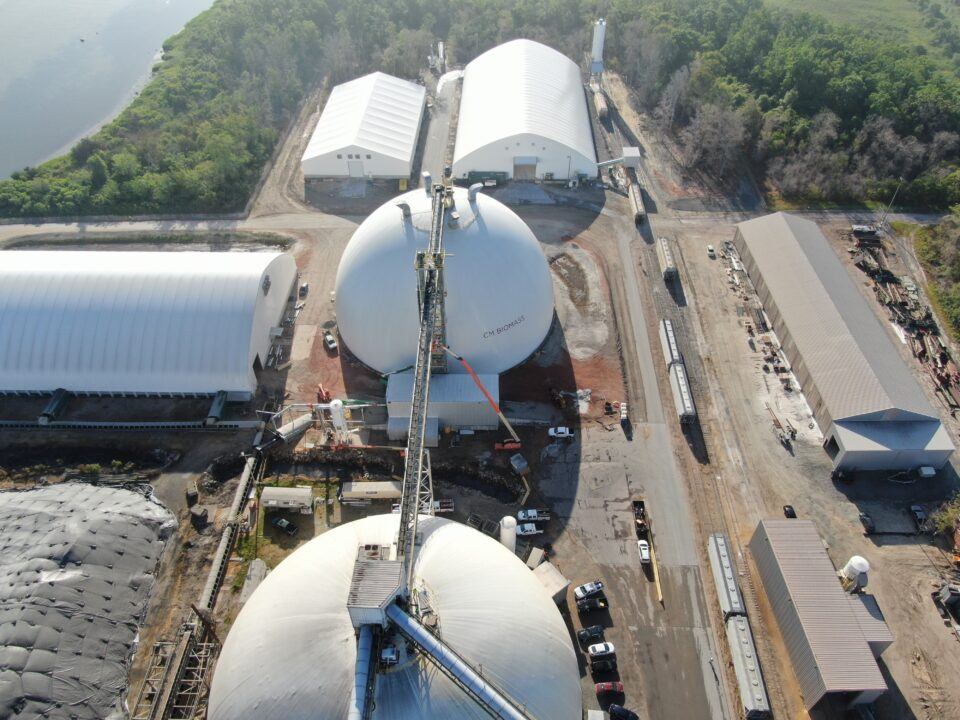
But “the hardest part of the job was tying in the new to existing facilities, both inbound and outbound,” Orwig said. The company had previously handled bulk products like rock and ore, so it was a must that the domes connect with infrastructure already in place. Even when hurdles arose, the Dome Technology team stayed on schedule, Orwig said, with the domes and tunnels being constructed in 10 months.
“(Dome Technology) is the only dome company we work with now,” he said. “I’ve worked with a lot of contractors, and Dome Technology is by far the most professional and the best contractor I’ve ever worked with.”
Dome Technology has built nearly all the wood-pellet storage domes in existence today. Here are some other noteworthy projects:
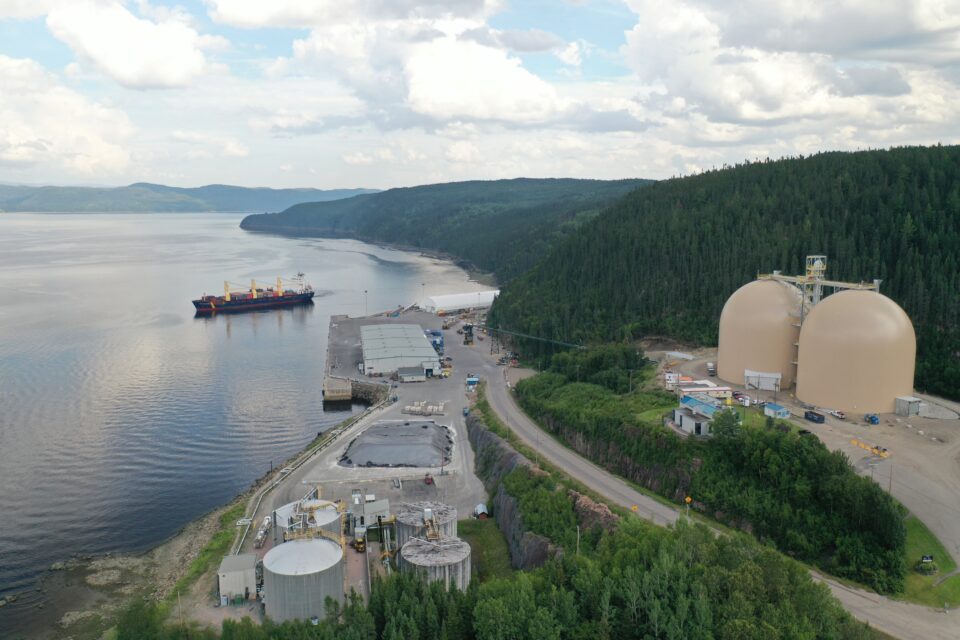
2020 Barrette-Chapais
Wood-pellet producer Barrette-Chapais first contacted Dome Technology about a ship-loader project for a new transload facility in Quebec, Canada, but when portside availability changed, so did their plans.
Flat storage was Plan A for the Port of Saguenay site, but after weighing a reduction in available space against storage requirements, the decision was made to shift to a dome, said Granule 777 general manager Yann Sellin.
Dome Technology was contracted to build two DomeSilos, measuring 120 feet (36.5 m) in diameter and 131 feet (39.9 m) tall and each capable of storing 21,000 metric tons. Because of their geometry, DomeSilos can store more product in a smaller footprint, stacking pellets deeper and storing them all the way to the structure’s apex.
According to Dome Technology sales manager Cameron High, one of the customer’s main requests was the ability for truck drivers to pull in, unload product and return to the pellet plant without interruption and on repeat. “They wanted from start to finish a fully automated system,” he said.
Dome Technology also acted as construction manager, supervising Canadian crews on all equipment installation — load-out system, bucket elevator and conveyance.
Pellets are produced at a Granule 777 pellet plant nearby. Upon arrival at the facility, they are dumped into a truck-unloading hopper and conveyed to a bucket elevator, which delivers them to a reversing conveyor on top of the domes.
The outbound conveyor on the reclaim side is 1,153 feet (351.4 m) long, reaching 357 feet (108.8 m) to collect product underneath both domes and stretching 796 feet (242.6 m) to ships that will deliver it to Europe.
Construction is tricky in such a cold climate, but the weather-resistant domes will protect pellets and last indefinitely with little maintenance. The dome was an optimal choice considering the extreme weather common in northern Quebec, High said.
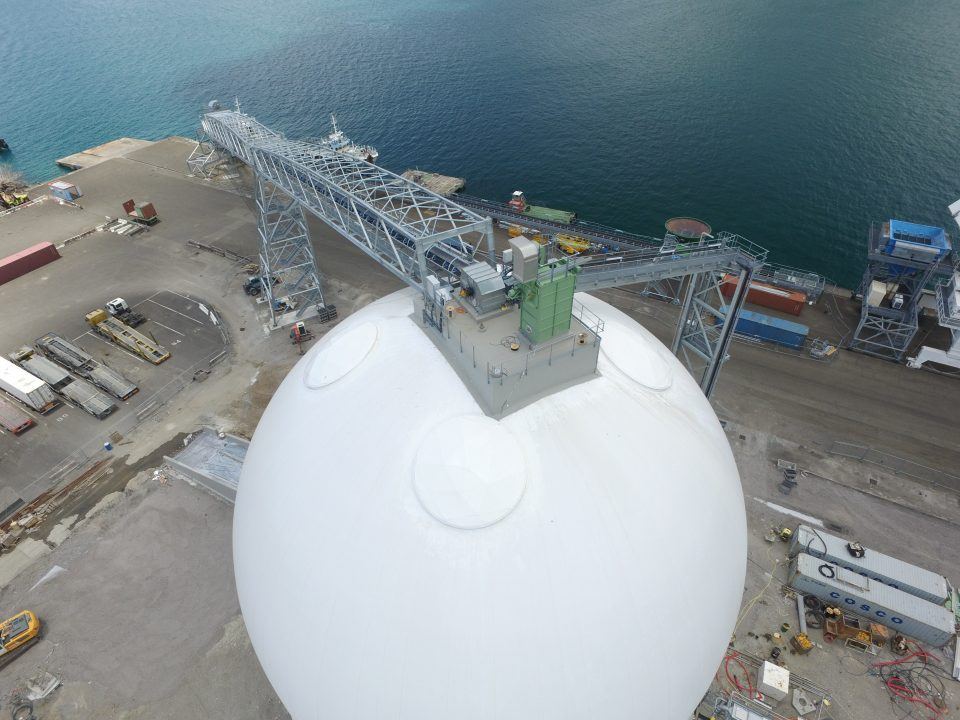
Albioma 2016
In Fort-de-France, Martinique, Dome Technology built a storage dome for independent energy producer Albioma, an important element in the island’s first 100 percent biomass power plant.
The single dome stands 108 feet (33m) tall and 115 feet (35m) in diameter, with the ability to store as much as 19,900 metric tonnes of biomass wood pellets. Dome Technology oversaw work for the deep-pile foundations, pile cap, dome shell and one above-grade tunnel. The dome achieves approximately 70 percent reclaim by gravity alone and has access for a front-end loader to reclaim the remaining 30 percent.
The self-emptying ability for a large portion of the volume was one of the factors that led Albioma to select a dome, said Albioma project director Claude Décamp. Though flat storage was an option, the large size as well as local conditions — specifically cyclonic and seismic risk and bad soil characteristics — would have required a very high investment cost. The dome was selected for its smaller footprint, less-expensive foundation, lower overall cost and higher storage capacity, Décamp said.
Dome Technology’s team also installed round explosion vents for better product and structure protection. Previously, square and rectangular explosion venting have been the norm, but with a round panel, sharp corners that would act as stress concentrators are eliminated. This allows a release of pressure, protecting the structure.
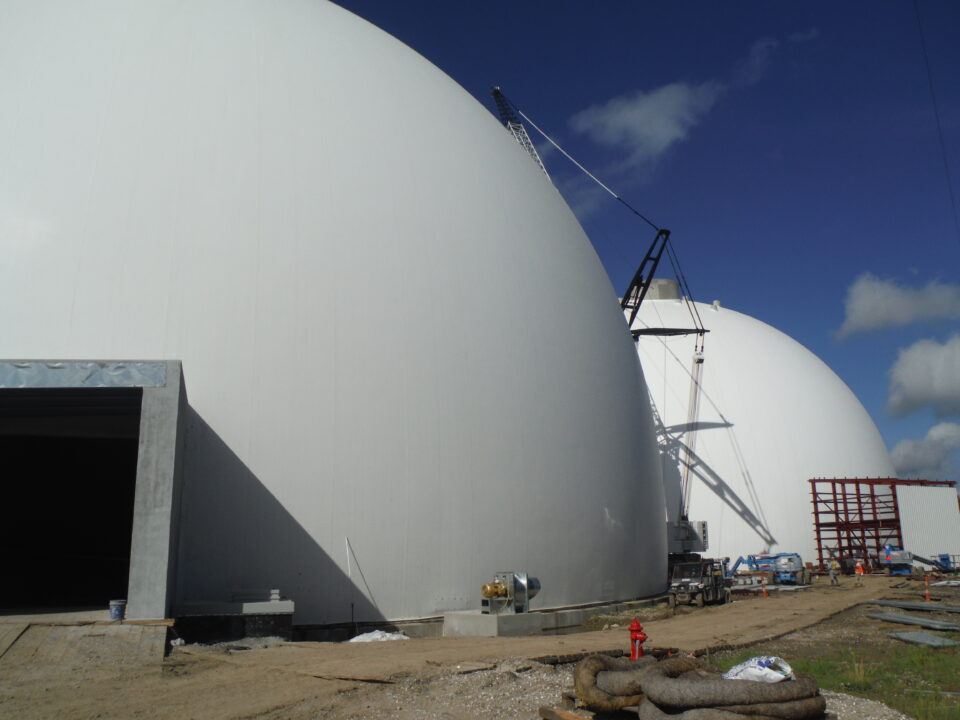
Drax Port Allen 2014
Dome Technology built two wood-pellet domes for Drax’s Port Allen Facility in Baton Rouge, Louisiana, USA. The total storage volume is 80,000 metric tons.
“The overall facility has less material handling equipment due to the domes. The domes also require less maintenance and fewer equipment issues, which allow the ships to be loaded on time. All these factors combined reduce the operational costs as well,” said senior project manager Daniel Pittman, who works for Gray Construction, the EPC Drax selected for the facility’s development.
Building a facility near a levee was a challenge too. Traditional foundation methods for dealing with saturated soil could be expensive, and then there was the question of whether tunnels could be constructed below ground. The design required approval from the Army Corps of Engineers due to stipulations necessary for projects built within 1,500 feet of the levee, which it received.
With these challenges in mind, Drax and Gray Construction researched bulk-storage options and determined that two 40,000-ton domes would cost less than silos and A-frames for the necessary building size, building cost and equipment cost. Additionally, Dome Technology was willing and able to tackle the project and design a cost-effective foundation system as an alternative to concrete piles.
“Dome Technology was selected due to their innovative engineering design and the project team’s comfort level with their design team,” Pittman said.
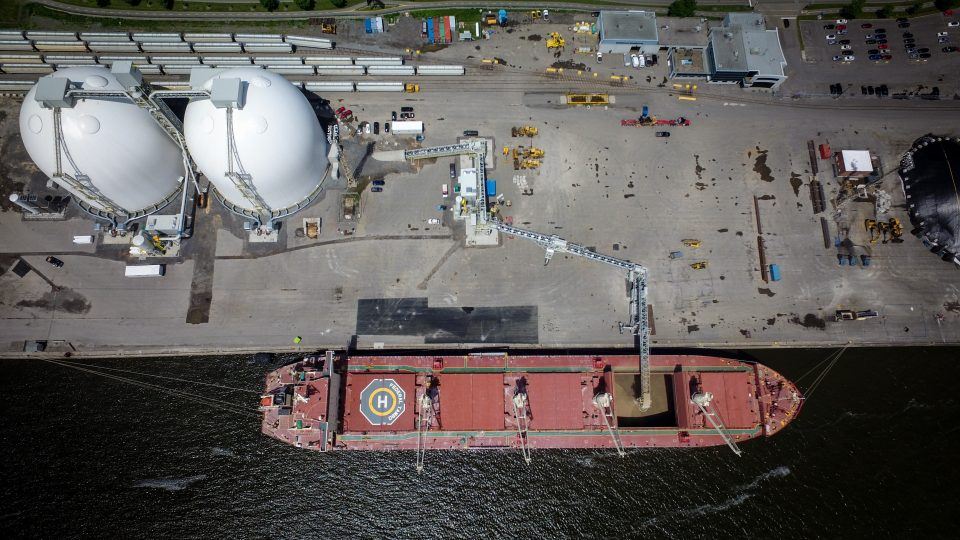
QSL 2013
From the beginning of its portside project in Quebec City, Quebec, Canada, the challenge for maritime terminal operator and stevedore QSL was selecting a wood-pellet storage solution that checked the boxes as both a smart financial investment and a good steward of the community.
First, the company required 75,000 metric tons of total storage. Steel silos were an option, but a pack of six to eight would be needed to store that tonnage. Since the site is located near a historic district with a park and residential area, something more aesthetically pleasing was in order, and a DomeSilo fit the bill. Dome Technology built two of them for QSL.
“We needed something nicer than a series of silos, so that was the main concern. Then also because of the size of storage, we needed something solid that would last a long, long time,” QSL director of engineering Eric Lapointe said.
Second, QSL was concerned about product integrity and wanted “something that wouldn’t attract too much solar heat from the sun. A concrete system like the dome was ideal to store the pellets. Because we can have no water infiltration whatsoever, domes are ideal for that as well,” Lapointe said.
Controlling dust was front of mind because of the nearby neighborhood. QSL liked the seamless nature of the dome, but the tightness presented its own challenge in mitigating potential explosion pressure in a deflagration event. After Dome Technology’s design team determined that the amount of potential volatile explosive content in a worst-case scenario would require very large explosion vents on the top surface of the dome, QSL sought an innovative approach. “We said, ‘Let’s try to minimize the amount of fuel so that if there is an explosion, we will need much smaller vents,’” Lapointe said.
That’s when Dome Technology presented the idea of the filling tube. A belt conveyor moves pellets into the top of the domes, where they enter a 10-foot-diameter steel tube running down the center of each dome. Product rolls through openings located incrementally on the tube and into the pile, resulting in smoother, more even pile and less dust production. When reclaiming the pellets, they are first drawn down from the center of the filling tube, then from each opening on the sides of the tube. This reduces the shear friction on pellets during reclaiming, minimizing further pellet degradation.
For additional dust management, “we installed a dust-collection manifold inside that tube so that (with) any pellets that come out of the tube, there’s much less dust,” Lapointe said. “There could still be an explosion, but the dust cloud would just be what’s inside that filling tube, so the volume of the cloud would be much, much smaller.” With the filling tube installed, the vent sizes dropped down and so did the venting cost.
Testing for dust concentration at four levels inside the dome all came back well below the minimum explosion fine concentration inside the dome. “We kind of got rid of the risk at the base. Instead of trying to mitigate if there is an explosion, we tried to prevent it from happening,” Lapointe said.

Drax UK 2012
There’s big, and then there’s staggering.
Drax chose the latter in a project that was a first of its kind for the United Kingdom, Europe’s single largest decarbonization project, and Dome Technology’s largest wood-pellet-storage project to date.
The size and scale of the project required unprecedented biomass storage: four domes each holding 80,000 metric tons of biomass. Dome Technology’s team was responsible for the overall design of the dome system, including reclaim tunnels, floor slabs, dome foundation, DomeSilos and waterproofing.
One important feature was the unique “tops” for the domes. The specialized design incorporates a 90-foot (27.4m) opening at the apex of each dome accommodating panels, which relieve and dissipate pressure should it arise due to a deflagration event. Using computational fluid dynamic models, the team calculated the needed surface area of relief, optimal placement and the required size of the roof opening.
With the four domes now in operation, Drax is providing enough power to meet around seven to eight percent of the United Kingdom’s electricity needs, half of which is generated by biomass.
“Dome Technology were keen and interested from day one, had experience with biomass and other similar products from previous projects and had over 75 reference projects worldwide,” said Drax’s strategic project engineering manager Jason Shipstone. “One or two little details were a little close to the wire in terms of timing, and like all large projects, we had our surprises, but overall the whole team worked well together and delivered a very effective project.”
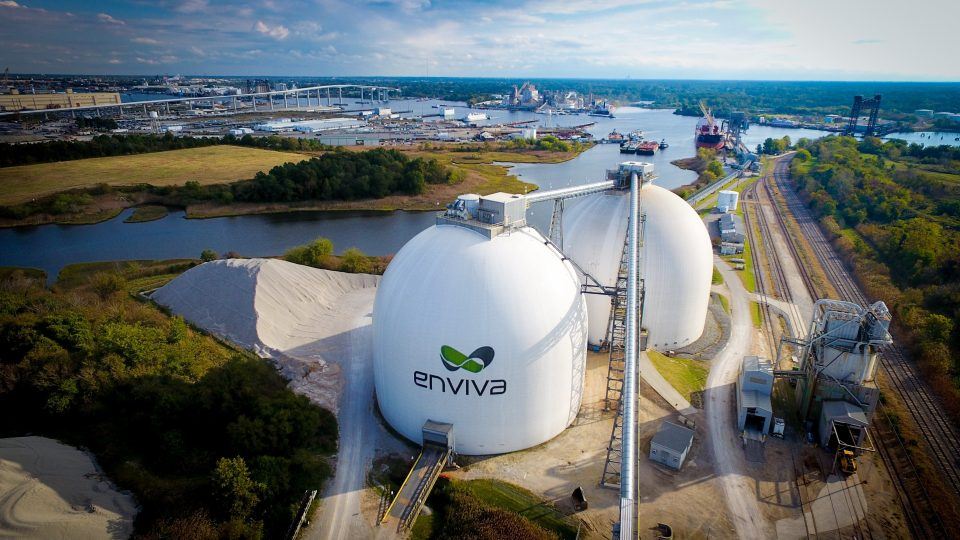
Enviva 2011-2014
In 2011 and 2012 two domes were completed for biomass manufacturer Enviva at the Port of Chesapeake in Virginia.
The domes feature systems that continuously monitor and control interior temperature. Through close collaboration with Enviva, Dome Technology’s team completed construction ahead of projected completion, even though the project started a month later than planned.
In 2014 the team was contracted to build two additional, almost identical domes at Port of Wilmington, North Carolina. These domes can withstand winds exceeding 300 mph.
Domes are an ideal bulk-storage option for wood pellets as they store a large volume in a smaller footprint, stacking product deeper than a silo of similar dimensions. For storage on a port, domes can be engineered with innovative foundation systems that provide ample support on soil near the water. Domes are also less likely to experience fires because the interior is truss and support free — the fewer the horizontal surfaces, the fewer places for dust accumulation.
According to Enviva Senior Vice President Norb Hintz, the company is pleased with Dome Technology’s work. “We appreciate the high-quality workmanship, professionalism and attention to detail demonstrated by their staff,” he said in a letter of recommendation.
In an era when innovation and customization aren’t extras, they’re expected, more bulk-storage companies seek a structure that will last, that fits within the budget and that will maintain product integrity. Dome Technology delivers an innovative, turnkey solution.
“Customers have, in the past, used different systems to store wood pellets until they found the dome. As a result, the dome has become the standard for storing pellets, and everyone knows it,” said Dome Technology CEO Bradley Bateman. “We’ve been able to create solutions when others could not.”